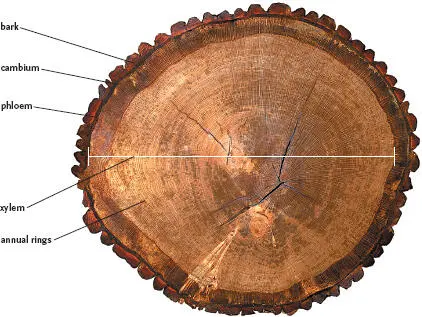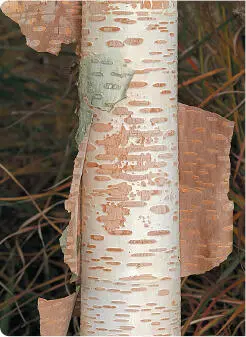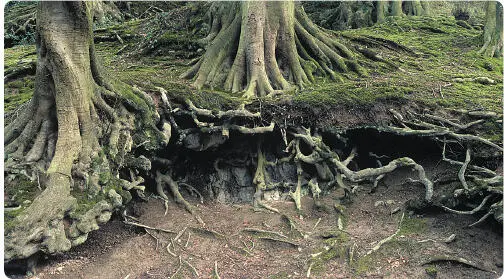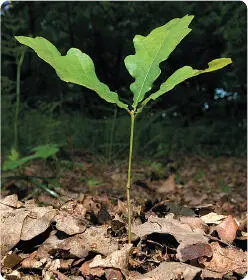The principal way in which a tree or shrub differs from other, herbaceous, members of its family is its ability to produce woody tissue; this serves to conduct materials around the plant, and leads to the production of permanent shoots. In the case of perennial herbaceous plants, the shoots die back at the end of each growing season, or in the case of annuals, the whole plant dies and a new generation arises from seeds formed by the previous generation.
Trees and shrubs have an important layer of cells enclosing shoots, buds and roots, called the cambium layer. This is an active layer that is constantly producing new cells on its inner and outer surfaces. Cells that grow on the inside of the cambium develop into woody tissue or xylem ; this conducts water from the roots to the shoots, buds and leaves. Eventually it forms the bulk of the trunk and branches of the tree as a new layer is laid down each year. Cells that grow on the outside of the cambium form the conductive tissue, known as phloem , that carries sugars from the leaves down to the roots. This vital layer must not be damaged. If a complete ring of this tissue is cut away from the trunk of a tree the roots will be deprived of nourishment from the leaves and the tree will eventually die.

A cross section through a Pedunculate Oak trunk reveals its many layers.
When the tree begins to grow vigorously in the spring it forms large conductive cells that allow sap to flow freely through the trunk. As the season advances, cells produced by the cambium layer become smaller, with thicker walls for support, so they give a more dense appearance. In winter, cell production slows down and then ceases for a while; come the spring, however, there is a sudden burst of cell production and large cells are produced once more. The new growth of large cells immediately next to the thinner layer of dense cells gives the appearance of a ring. By examining a cut stump it is possible to count the rings and therefore discover the age of the tree, and also to find out which were the best growing seasons ( see pp.).
The bark is an important part of a tree, protecting the vital growing layers of cells below from varying environmental conditions. It is produced by a layer of cambium cells and grows to accommodate the increasing girth of the tree. It may be thin and papery, smooth and shiny, or thick and deeply furrowed. Each type of bark is matched to the tree’s environment, so tree species that are subject to heat and strong sunlight in their native ranges have a thicker bark than those that come from cooler, humid climates ( see also pp.).

Himalayan Birch bark is relatively thin and peels readily.

while Pyrenean Oak bark is thick and corky.
The first part of a tree to emerge from a seed is a tiny root whose first function is to draw up water and dissolved minerals from the soil. In the case of most of our tree species, successful germination is dependent upon this first root making contact with a species-specific symbiotic fungal partner, a relationship that continues for the rest of the tree’s life. This relationship is discussed in more detail on p. 34. From this simple start the tiny root will grow and divide, eventually forming a large network of powerful roots, side-branches and fine root hairs that spread out in all directions around the base of the trunk. The main roots will be woody and very strong, but their many branches terminate in fine root hairs that are only a few cells long; these have thin, permeable walls through which will pass all the water and minerals needed for the survival and growth of the tree. Although the sturdy roots strengthened with woody tissue help anchor the tree in the ground, it is the millions of fine root hairs that keep the tree alive by supplying it with water and nutrients. These fine root hairs are very short-lived, being constantly replaced as the main roots grow through the soil.
The root system of a large, mature tree does not penetrate far down into the soil. The most useful supply of dissolved nutrients for the tree lies in the shallow layer of topsoil and the adjacent sub-soil, so it is more beneficial if the roots spread outwards through this layer rather than penetrate to a great depth into a rather sterile and hostile layer. A 50mtall tree will probably have a spread of smaller branching roots all around the bole, the extent approximately equal to the spread of the branches or, sometimes, to the height of the tree. The proximity of other trees, the nature of the soil, and the presence of obstacles like rocks or river banks will all influence the final extent of the root system, however. This knowledge of the spread of the roots is useful when planning where to plant large trees that may damage drains or the foundations of buildings when they reach maturity, and it should also be borne in mind when digging ditches or ponds near large trees.

Spreading Beech roots.
In order to be able to function at all, roots require a supply of nutrients from the leaves, so within the root system there is a two-way traffic of water and minerals up from the soil to the leaves, and dissolved sugars and other nutrients down from the leaves.
The root hairs are living cells that require oxygen in order to be able to carry out respiration. They give off carbon dioxide as a waste gas, so they need access to air in the soil to allow these gases to circulate. Most trees, and most land plants, cannot grow in completely waterlogged soils and those that do have special adaptations for survival.
A number of trees, especially members of the Fabaceae, such as the Honey Locust, have many rounded nodules on the roots that contain colonies of nitrogen-fixing bacteria. These are able to use gaseous nitrogen and turn it into compounds vital to the growth of the plants.
Leaves are among the most conspicuous and distinctive features of any tree. They grow in a huge variety of shapes, sizes, colours and combinations and are usually the best feature for identifying the tree because of their unique structure. Leaves may vary from one species to another but they all perform the same vital function as the principal producers of food for the tree.
The first pair of leaves to emerge from the seed are simple, and bear no resemblance to the true leaves of the tree; they are derived from the seed’s food store. They are green, however, and supply the tiny seedling with its first food made from sunlight energy. Once the seedling has begun to produce leaves that are miniature versions of its true leaves, growth can begin very rapidly. Tiny seedlings are vulnerable to grazing, trampling, drought and competition, so very few survive.

Recently germinated oak seedling.
Читать дальше

















